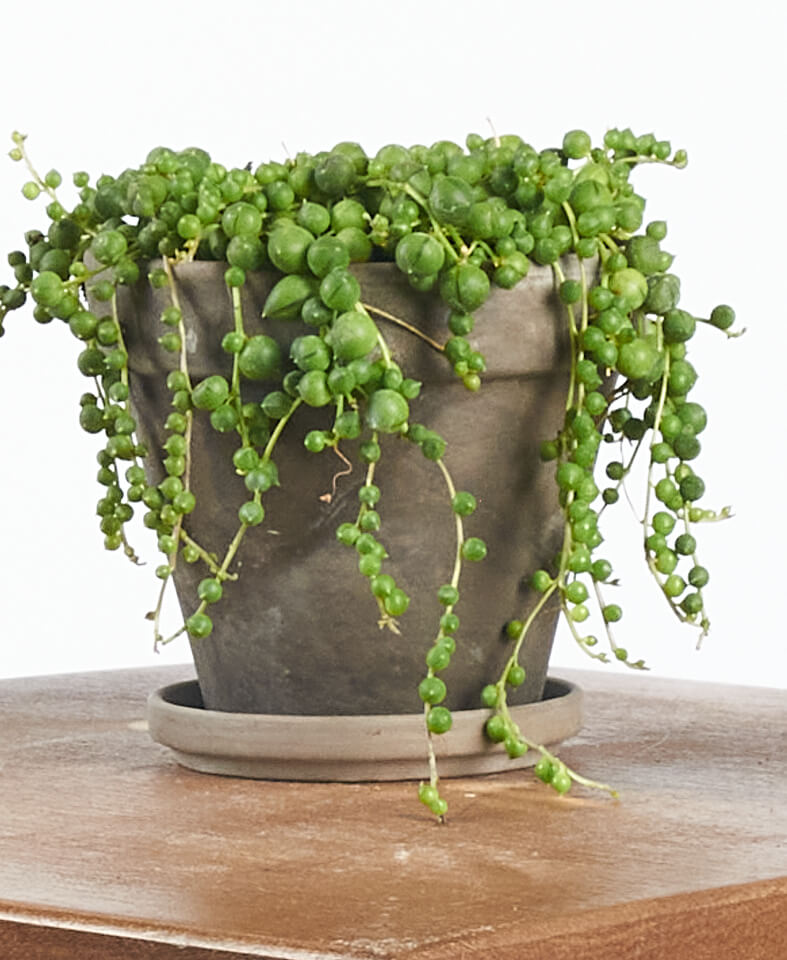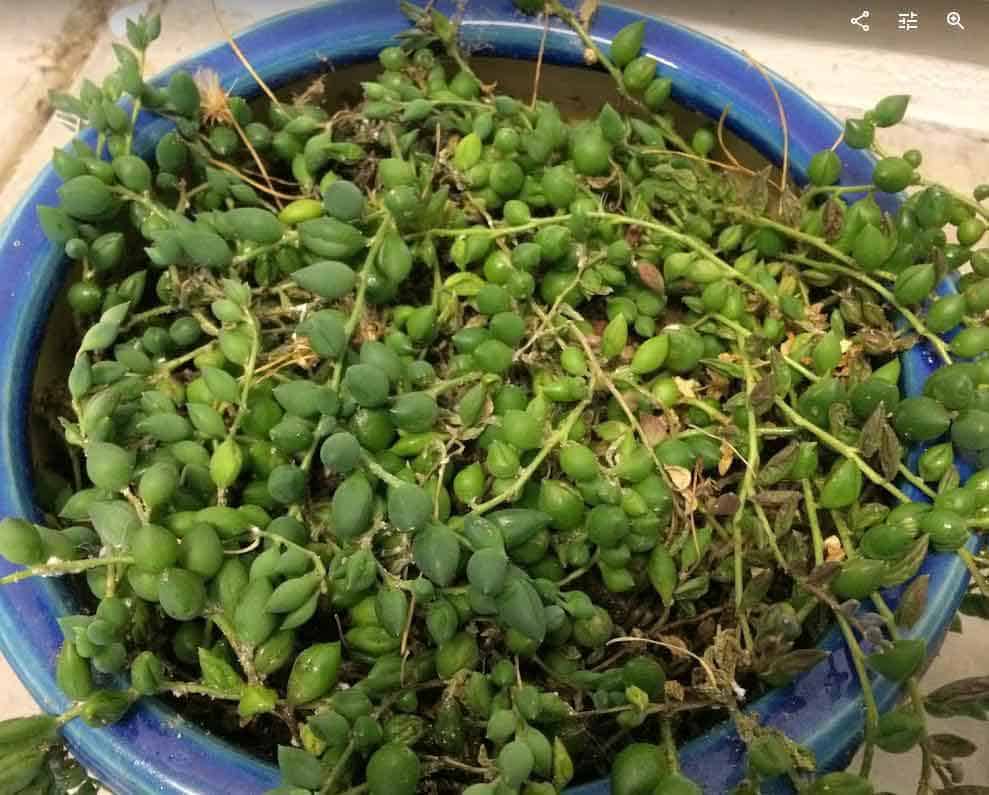The string of pearls plant, also known as Senecio rowleyanus, is a trailing succulent known for its unique, spherical leaves. With proper care, this plant thrives and cascades beautifully in hanging baskets. However, the string of pearls is prone to wilting and dying if its needs aren’t met. Don’t give up hope if your plant is struggling – with some troubleshooting, you can nurse it back to health.
Common Signs Your String of Pearls is Dying
Here are some common signs that indicate issues with your string of pearls
- Wilting, drooping, or shriveling pearls
- Yellow or brown discolored pearls
- Pearls falling off stems
- Bald spots on vines
- Soft, mushy pearls
- Wrinkled, deflated-looking pearls
- Excessive leaf drop
These symptoms usually point to an underlying problem with water, light, or soil conditions. With some adjustments to care, you can still save your plant.
Reasons Your String of Pearls Might be Dying
Overwatering
The #1 reason string of pearls decline is overwatering, Too much moisture causes the roots to rot and leaves to become soggy, Water only when the top inch of soil is dry,
Underwatering
While they don’t need frequent watering, allowing the soil to completely dry out can also cause leaves to shrivel and drop.
Poor Draining Soil
Soil that retains too much moisture prevents roots from getting oxygen Repot in a fast draining cactus or succulent mix
Lack of Light
Insufficient sunlight causes weak, sparse growth. Place in bright, indirect light or provide several hours of direct morning sun.
Pests
Spider mites, fungus gnats, or mealybugs can infest and damage string of pearls. Inspect undersides of leaves and treat accordingly.
Cold Exposure
If left in temperatures below 50°F, leaves turn brown and vines die back. Move to a warmer spot in winter.
How to Revive a Dying String of Pearls
If your plant exhibits multiple signs of distress, don’t panic! Here are some tips to nurse it back to health:
-
Cease watering and allow soil to fully dry out before next watering. Discard any rotted or mushy roots.
-
Repot in fast draining cactus/succulent mix, terra cotta, or add perlite to improve drainage.
-
Prune off any dead or dying vines back to healthy growth.
-
Place in bright, indirect sunlight or use a grow light to provide adequate brightness.
-
Mist leaves and provide increased humidity while plant recovers.
-
Apply a balanced fertilizer to nurture new growth. Feed weekly at 1/4 strength.
-
Propagate healthy strands in water or soil to start over if needed.
-
Keep out of drafty areas which can cause leaf loss.
With some TLC, you can nurse your string of pearls back from the brink. Consistent conditions and proper care will reinvigorate its vines to cascade beautifully once again. Don’t toss it out until you’ve tried everything to save it!
How to Prevent Future Issues with Your String of Pearls
Once you’ve revived your plant, keep it thriving by providing ideal care:
Water Thoroughly
- Water only when top inch of soil is dry to the touch
- When watering, drench soil until water drains from bottom
- Allow pot to drain fully to prevent soggy soil
Choose a Fast Draining Potting Mix
- Use cactus/succulent soil or amend with perlite for drainage
Increase Light Exposure
- Provide at least 3-4 hours of direct morning sunlight
- Supplement with grow lights if sunlight is inadequate
Monitor for Pests
- Check undersides of leaves for webs, insects, or specks
- Quarantine new plants to prevent introducing pests
- Treat infestations early with insecticidal soap or neem oil
Avoid Temperature Extremes
- Keep above 50°F and avoid cold drafts
- Move to warmer location in winter if needed
Reduce Handling
- Limit touching leaves or vines to prevent pearls dropping
- Use saucers or trays underneath pots when moving
With the proper care, your string of pearls will flourish, reward you with lush trailing vines, and live up to its reputation as an easy-to-grow succulent. Novice growers, don’t dismay if you’ve made some missteps. Adjust your care and with a little time you’ll have a thriving string of pearls spilling beautifully over its container.
It can be alarming to notice the top of your String of Pearls drying out and dying, but don’t worry! You’ve got this.

Most likely, the thin, crispy top of your String of Pearls is because the plant isn’t getting enough light on top of the pot. Take a few strands of pearls and lay them on top of the soil. This is an easy fix. Use some garden pins to pin them down, so they are touching the soil. In a few weeks, these will send down new roots into the soil, making your pot look full and beautiful again! To keep this from happening again, make sure the whole pot gets enough light. At least 4-6 hours of light per day is ideal.
The sparse top of your String of Pearls can also be caused by over-watering. Make sure to only water your plant after the soil is completely dried out. Make sure to use your finger to check the soil. String of Pearls is a drought-resistant plant and is prone to over-watering and root rot. A sign that your plant is thirsty is when the pearls start wrinkling and look smaller. When this happens, you know it is time for a drink of water!.
HOW TO SAVE SAD AND DYING STRING OF PEARLS
FAQ
How do you revive a dying String of Pearls?
What does an overwatered String of Pearls look like?
How often do you water strings of pearls?
Why are String of Pearls so hard to keep alive?
Why are my string of pearls dying?
Let’s find out! Inadequate watering, poor lighting, and fluctuating temperatures are major causes of a dying string of pearls. Apart from this, blockage of drainage and a pest infestation can also result in wilting of the plant. You can save a dying string of pearl by identifying the problem and fixing the issue.
What happens if a string of pearls leaves fall off?
This prevents leaf discoloration and an angry plant. If the damage is already done, all you can do is provide your plant with the usual string of pearls care and keep your fingers crossed. Some of the affected leaves may fall off, but the plant itself should usually bounce back fine.
Can string of pearls damage a plant?
If the damage is already done, all you can do is provide your plant with the usual string of pearls care and keep your fingers crossed. Some of the affected leaves may fall off, but the plant itself should usually bounce back fine. Did you know? Overfertilization can also cause leaf discoloration like yellowing or browning.
How to save a dying string of Pearl?
You can save a dying string of pearl by identifying the problem and fixing the issue. Though the string of pearls can tolerate extreme conditions, they can get stressed if something is wrong, leading to a lot of other problems or diseases.
- The Ultimate Guide to Growing Strawberries in Raised Beds - August 8, 2025
- No-Dig Garden Beds: The Easiest Way to Grow a Beautiful Garden - August 6, 2025
- How to Protect and Preserve Wood for Raised Garden Beds - August 6, 2025

